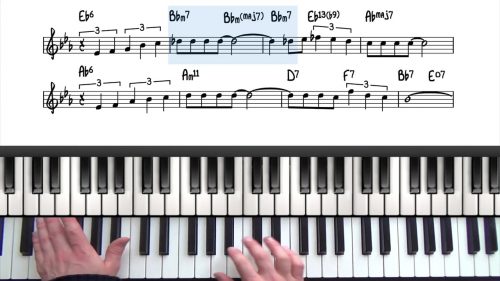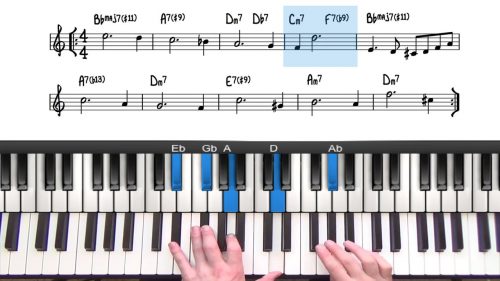Darn That Dream Tutorial
In this 2 part lesson, we create an arrangement for the well-known standard ‘Darn That Dream’. The tune is written in the key of G Major and follows an A1 A2 B A2 form.
The melody features lots of chromaticism which can be challenging to harmonise in places. We’re going to jump straight in with two handed chords but we will also add variety with some rootless left hand voicings.
In terms of theory, we will cover the usual stuff like extended and altered harmony, upper structures and inner voice movement. Then we’ll also introduce some more examples of pentatonic and diminished harmony.
Practice Tips
You can find a link below to many great recordings of the tune. Remember to spend at least a quarter of your daily practice time listening and transcribing and this will do wonders for your improvisation skills and general musicality.







This is such a great tune and your arrangement is terrific. Thanks, Hayden!
Thanks Rebecca, glad you enjoyed the lesson!
Cheers,
Hayden
Is there a part 2 lesson for Darn That Dream? If so I cannot find it. Thanks, Ed
Hi Ed,
Yes here is is: pianogroove.com/jazz-piano-lessons/darn-dream-part-2/
Enjoy the lesson!
Cheers,
Hayden
Great arrangement. I keep searching for the ‘standard’ way to write these complex arrangements. In general, unlike late 19th century composers, Jazz composer/arrangers avoid double sharps and double flats and generally avoid Cb, B# and Fb, E# too. A good example of this is in measure 4 on the third beat jazz composer like you would rather see G natural as the #9 of the E7 chord rather than F double sharp (and so do I) I’ve been taught that when we have a complex chord with altered tones to use the spelling best suited for the chord rather than the key signature. Now I know that my music program (Finale) is not good at doing that and so I must always check it.
Looking at this arrangement, I sometimes stumble over reading some of the voicings until I ‘rewrite’ in my head some of the enharmonic spelling. I always want to see the essential tones of the chord spelled ‘correctly’. For example, in measure 10 on the third beat I’d rather see D# (rather than the Eb) for the third of B9 #11 as it is one of the essential tones for the dominant chord. That said I’m not bothered by the use of Db for the 9 (I guess ‘correctly’ would be spelled C#) and I definitely would rather see F natural for the #11 rather than E#. That said I’d find spelling the top major third very awkward if it were spelled as a diminished fourth with the 9 as C# and the #11 as F natural. So my question is, “Is there a correct way to spell these chords in the jazz world?
Other examples in this arrangement,
1) measure 12 third beat Ab => G# (third of E7)
2) measure 17 A# => Bb (fifth of Eb)
3) measure 18 third beat Ab => G# (and maybe a courtesy natural for G natural in the treble clef)
I think there are a few typos as well:
1) second chord in measure 7 is D7b9
2) second chord in measure 9 Eb13(sus4)
3) Measure 10 third beat and 4th beat B9 #11, B7 b9
4) Third beat measure 15 D7b9
5) m 18 1 beat F# => F natural (Midi file has this right)
6 m 18 3 beat => E7 #9
7) m 20 F#=> F
8) 2nd chord in m 22 ->D7b9
9) m31 beat 3 I hear the root as D so therefore D7b9 (half whole scale)
Again I love the course and there is value in me finding little mistakes as a student. Is it helpful to you for me to do this with some of the other arrangements. You’ve got a lot on your plate and I imagine you play the arrangements into the computer and then do your best to clean them before publishing them. I find great value in seeing the concepts you present in these arrangements even though I know you’ve told me that one doesn’t learn jazz by reading.
Regardless I hope this note find you well.
Thanks again for a great course.
Fondly
John
I found an example of a chord that you ‘perfectly’ spell ‘correctly’ but that still is not easy for me to sight read. It basically invalidates my comments above. :( This comes from your arrangement of Pure Imagination. Note the last beat of Measure 10 is a F7 b9#11 voicing which is a perfectly spelled example of a #11 Triad over a dom7. It would be easier for me to read the second inversion B triad as F# B D# but that would mean having both D# and Eb as well and an F and F# (generally something I like to avoid) as well as a diminished 4th (which I generally like to discourage).
So… it’s back to the drawing board for me to find a methodology for writing complex chords ‘perfect’ly. I suspect this is like trying to invent the perpetual motion machine. I hope this didn’t confuse anyone.
Sigh
John
Please let me know your thoughts to my previous comment. I forgot to check it
John